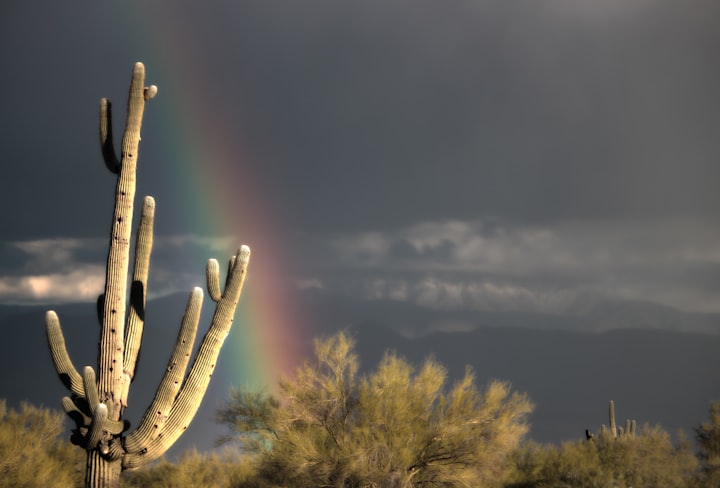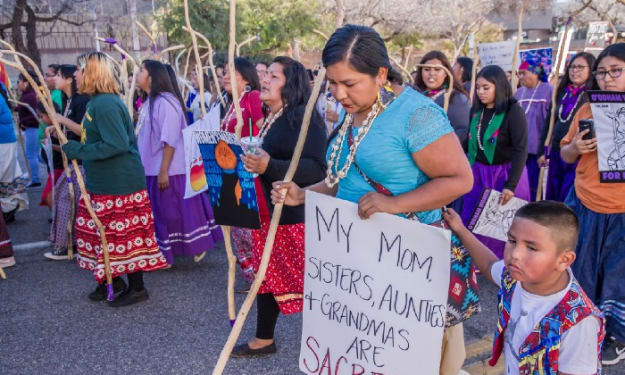Cactus Thieves Plague Arizona’s Deserts
Many species of cactus grow only in the American southwest, but demand in markets from Europe and Asia has pushed thieves to steal the slow-growing plants from public lands.

Arizona’s deserts are home to the world’s densest forests of towering saguaro cacti. These cactus grow up to 50 feet during their lifespan, which can last as long as two hundred years. However, these stoic giants face a pervasive threat — poachers who dig them up under the cover of darkness to resell on a growing worldwide cactus black market.
Saguaros only grow in a small area, 120,000 square miles in the Sonoran Desert spanning sections of Arizona, California, and Sonora. The column-like cactus usually grows at least a few arms and sprouts yellow and white flowers, called saguaro cactus blossoms, Arizona’s state flower. Saguaro National Park in Tucson, Arizona has one of the largest collections, with an estimated one million saguaros currently in the park. Large saguaros often weigh over 2000 pounds, making their removal difficult. So cactus rustlers target smaller saguaros that are between four and seven feet tall, which takes 30 to 50 years to grow. The cactus usually sell for about $100 per foot.
Before settlers came to Arizona in the 1700s, Native American tribes like the Tohono O’odham cultivated the saguaro cactus. After the cactus reaches 30 years of age, they can produce up to 30 fruits per year. The sweet saguaro fruit has red pulp and hundreds of small black seeds. Gatherers would hit the fruit off the top of the towering cactus to collect it. Along with wild game and beans of the mesquite tree, saguaro fruit would be a sweet indulgence in their diet. So appreciated was the saguaro fruit, that there was even a festival to celebrate it. The versatile fruit could be turned into jam, syrup, seed flour, and even wine. Even now, it’s not hard to find saguaro jams and jellies in Tucson, especially in tourist shops. Arizona’s Native Americans found the region hospitable and enjoyable, when the Spaniards could not, pointing to their resiliency and respect for the land and native plants that the Spanish settlers did not have.
Arizona’s thieves of yore were the feared cattle rustlers who’d steal livestock grazing in the desert and hastily change the branding on their hides. The penalties for cattle rustling were often harsh, but the rewards often outweighed the risks for bandits looking to make their way in the harsh Wild West, where there were few social safety nets. Other bandits made their way by robbing the newly constructed railroads. In Arizona and New Mexico, robbing a train was punished by death, due to political pressure from railroad companies. This was rescinded, however, after a case where the jury refused to convict a non-violent train robber. Then, in 1881 in the frontier town of Tombstone, a legendary gunfight erupted at the O.K. Corral between Wyatt Earp, Doc Holliday, and outlaws from the Cowboys bandit gang. The 30-second shootout ended with three deaths but made its way into Wild West legend as the most famous gunfight in American history. “Curly Bill” Brocius was another famous outlaw and cattle rustler in the Arizona Territory and was known for his many conflicts with the Earp family of lawmen.
But that era of banditry and train heists fell by the wayside and in recent decades, a new type of theft has brought havoc to the desert: cactus rustlers looking to make a quick buck poaching and selling the grand saguaros to sellers on the booming plant market.
“There are two deserts: One is a grim, desolate wasteland. It is the home of venomous reptiles and stinging insects, of vicious thorn-covered plants and trees and unbearable heat. This is the desert seen by the stranger speeding along the highway, impatient to be out of the ‘damnable country.’ The other desert — the real desert — is not for the eyes of the superficial observer or the fearful soul of a cynic. It is a land which reveals its true character only to those who come with courage, tolerance and understanding. For these, the desert holds rare gifts: a health-giving sunshine; a sky that after the sun goes down is studded with diamonds; a breeze that bears no poison; a landscape of pastel colors such as no artist can reproduce; thorn-covered plants which during countless ages have clung tenaciously to life through heat, drought, wind and the depredations of thirsty animals, and each season send forth blossoms of exquisite coloring as symbols of courage that triumphed over appalling obstacles,” said Joshua Tree National Park advocate Randall Henderson in the mid-twentieth century.
Saguaro National Park in Tucson was first declared a national monument in 1933 by President Hoover in the Antiquities Act due to the “exceptional growth thereon of various species of cacti, including the so-called giant cactus.” Homesteads and copper mining operations threatened the desert ecosystem, which led the government and local conservationist groups to take action. This Sonoran Desert park now spans 91,000 acres.
To protect their unique deserts from turning into wastelands, Arizona needed to act. And act, they did. Arizona has some of the toughest laws on native plant protection and wildlife poaching. It is illegal in Arizona to remove a native plant and move it to another property without first obtaining a state permit for each plant. The Arizona Revised Statutes make native plant destruction or theft up to a class four felony, which puts it on equal footing with crimes like arson or possessing four or more pounds of marijuana.
It’s not only the law protecting saguaros now. Rangers at Saguaro National Park, for instance, began a program to implant tiny microchips into saguaros. These microchips track potential theft and sale and allow for retrieval. If officials see someone in Tucson transporting a saguaro, they can wave a chip reader near it and immediately detect if there is a microchip. Officials often frequent local nurseries, another popular fence for saguaro rustlers, to check for stolen cacti.
The first implementation of microchipping cacti was at the Lake Mead National Recreation Area in Arizona and Nevada. Officials say the project was successful and worked to decrease poaching while also helping them record cacti in the park.
In the 1990s, the market was much smaller and contained to people in the booming cities of Phoenix and Tucson who wanted cacti for landscaping. With the advent of the internet and the growing popularity of succulents, now the whole world is a market. Many species of cactus grow only in the southwest, but these cacti have captured imaginations worldwide and demand in markets from Europe and Asia has pushed thieves to steal the slow-growing plants from public lands.
In recent years, the succulent craze has led to a rise in cactus poaching, along with new markets on other continents. In the United States alone, the sale of cacti and succulents rose over 60 percent between 2012 and 2017, a rise seen in countries around the world. Within glossy magazine spreads of trendy home decor from China to Europe, it’s not uncommon to see a cactus or two as an ornament. In 2013, US border patrol seized 411 stolen cacti. In 2014, that number surged to over 2600.
Take, for instance, the sclerocactus havasupaiensis. This extremely rare cactus grows only in one location at the bottom of the Grand Canyon. But in 2019, a seller posted one to eBay from Ukraine. One ranger described for The Guardian finding a bunch of small holes where he knew sclerocactus havasupaiensis used to grow.
The issue with the demand is that cacti are often very slow-growing, so there is no way to meet the current, instant demand for more cactus unless the sensitive species are poached from the ground, often in public lands. Around one-third of cactus species are endangered and their biggest threat, according to researchers, is poaching.
In an interview with the radio station KJZZ, Tucson journalist Annette McGivney gave a scale to the issue of the growing consumer cactus market based on trendy home decor.
“The thing about cactus specifically in terms of house plants is that with a ficus or an ivy plant, it’s easy to grow in a nursery from seed quickly and people can do it that way… I saw cactus that had been stolen that were the size of a tennis ball that the nursery owner said were 40 to 60 years old. So you know, if a cactus becomes trendy in South Korea, you can’t wait 40 years to meet that market demand by growing it in the nursery so that’s why they’re being stolen from public lands,” Annette told the radio station. “I think ultimately what’s going to turn this around is awareness on the consumer end and even internationally around the world. I feel like if people knew what was happening in these environments, where the cactus they love are being stolen, they might be more sensitive about making sure that they were ethically sourced. There’s attention now given to coffee, that it’s ethically grown and that’s a common thing now for people to pay attention to.. I feel like the same thing needs to happen with cactus.”
Richard A. Countryman worked to protect native plants and cacti in Arizona in the 1970s and 1980s. Due to his outspoken conservation work, he received death threats, rocks thrown through his windows, the brake lines in his car severed, and he was even shot at.
“We get a lot of new people moving here and they don’t see the beauty or the fragility of the land. Every year you have to go farther and farther out from the city to find the desert,” he said in a 1982 interview with the New York Times.
The fragile beauty of the desert, in its complex relationships between cacti, desert plants, and the animals that live off them, needs protection from poachers and vandals. This fight for the desert is reaching new heights. As the demand for novel cactus grows overseas, this trend is pushing some species to the brink of extinction in their natural environments.
About the Creator
Raisa Nastukova
Freelance journalist focused on stories of both Kashmir culture and society as well as the rising tide of climate change.






Comments
There are no comments for this story
Be the first to respond and start the conversation.